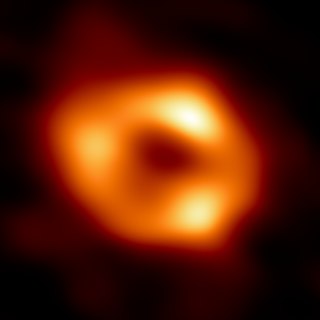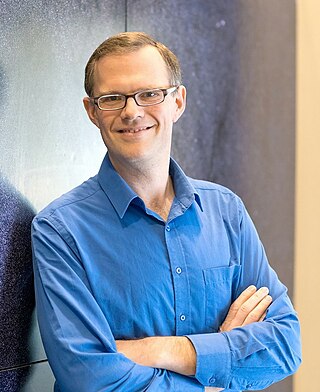Related Research Articles

The Local Group is the galaxy group that includes the Milky Way. It has a total diameter of roughly 3 megaparsecs (10 million light-years; 9×1019 kilometres), and a total mass of the order of 2×1012 solar masses (4×1042 kg). It consists of two collections of galaxies in a "dumbbell" shape; the Milky Way and its satellites form one lobe, and the Andromeda Galaxy and its satellites constitute the other. The two collections are separated by about 800 kiloparsecs (3×106 ly; 2×1019 km) and are moving toward one another with a velocity of 123 km/s. The group itself is a part of the larger Virgo Supercluster, which may be a part of the Laniakea Supercluster. The exact number of galaxies in the Local Group is unknown as some are occluded by the Milky Way; however, at least 80 members are known, most of which are dwarf galaxies.
Hubble's law, also known as the Hubble–Lemaître law, is the observation in physical cosmology that galaxies are moving away from Earth at speeds proportional to their distance. In other words, the farther they are, the faster they are moving away from Earth. The velocity of the galaxies has been determined by their redshift, a shift of the light they emit toward the red end of the visible spectrum.

A stellar black hole is a black hole formed by the gravitational collapse of a star. They have masses ranging from about 5 to several tens of solar masses. The process is observed as a hypernova explosion or as a gamma ray burst. These black holes are also referred to as collapsars.

Sagittarius A*, abbreviated Sgr A*, is the supermassive black hole at the Galactic Center of the Milky Way. It is located near the border of the constellations Sagittarius and Scorpius, about 5.6° south of the ecliptic, visually close to the Butterfly Cluster (M6) and Lambda Scorpii.
Rychard J. Bouwens is an associate professor at Leiden University. He is also a former member of the Advanced Camera for Surveys Guaranteed Time Observation team and postdoctoral research astronomer at the University of California, Santa Cruz. He obtained his bachelor's degree in physics, chemistry, and mathematics from Hope College. He then went on to earn his Ph.D. in physics at the University of California, Berkeley under the supervision of Joseph Silk and also worked with Tom Broadhurst.

The Dark Energy Survey (DES) is an astronomical survey designed to constrain the properties of dark energy. It uses images taken in the near-ultraviolet, visible, and near-infrared to measure the expansion of the universe using Type Ia supernovae, baryon acoustic oscillations, the number of galaxy clusters, and weak gravitational lensing. The collaboration is composed of research institutions and universities from the United States, Australia, Brazil, the United Kingdom, Germany, Spain, and Switzerland. The collaboration is divided into several scientific working groups. The director of DES is Josh Frieman.
Lyman-break galaxies are star-forming galaxies at high redshift that are selected using the differing appearance of the galaxy in several imaging filters due to the position of the Lyman limit. The technique has primarily been used to select galaxies at redshifts of z = 3–4 using ultraviolet and optical filters, but progress in ultraviolet astronomy and in infrared astronomy has allowed the use of this technique at lower and higher redshifts using ultraviolet and near-infrared filters.

Xiaohui Fan is an American astronomer, and full professor at University of Arizona. He is widely known for his studies on quasars, extremely bright supermassive black holes, detected primarily at high redshift. In 2003, Fan was named to Popular Science magazine's annual Brilliant Ten list for developing methods to investigate distant quasars. Since 2001, he was a pioneer in the detection and discovery of high-redshift quasars, introducing new techniques and practically inventing the field. Using these quasars, he has shown that supermassive black holes with masses up to 10 million solar masses existed within one billion years after the big bang. In 2019, he led an international team of astronomers that discovered the farthest lensed quasar thus far, the very first in the epoch of reionization. In 2021, his team announced the discovery of the most distant and oldest known quasar, QSO J0313–1806.

9Spitch is a gravitationally lensed system of two galaxies. The nearer galaxy is approximately 2 billion light-years (610 Mpc) from Earth and is designated SDSS J020941.27+001558.4, while the lensed galaxy is 10 billion light-years (3.1 Gpc) distant and is designated ASW0009io9. It was discovered in January 2014 by Zbigniew "Zbish" Chetnik, an amateur astronomer from Northamptonshire, England, while classifying images on the website Spacewarps.org. The discovery was announced on the BBC television programme Stargazing Live.

SN Refsdal is the first detected multiply-lensed supernova, visible within the field of the galaxy cluster MACS J1149+2223. It was named after Norwegian astrophysicist Sjur Refsdal, who, in 1964, first proposed using time-delayed images from a lensed supernova to study the expansion of the universe. The observations were made using the Hubble Space Telescope.
Crater 2 is a low-surface-brightness dwarf satellite galaxy of the Milky Way, located approximately 380,000 ly from Earth. Its discovery in 2016 revealed significant gaps in astronomers' understanding of galaxies possessing relatively small half-light diameters and suggested the possibility of many undiscovered dwarf galaxies orbiting the Milky Way. Crater 2 was identified in imaging data from the VST ATLAS survey.

NGC 4993 is a lenticular galaxy located about 140 million light-years away in the constellation Hydra. It was discovered on 26 March 1789 by William Herschel and is a member of the NGC 4993 Group.
Sangeeta Malhotra is an astrophysicist who studies galaxies, their contents, and their effects on the universe around them. The objects she studies range from our own Milky Way galaxy to some of the earliest and most distant known galaxies in the epoch of cosmic dawn.

Peter Lawrence Capak is currently the Architect of Perception Systems at the Oculus division of Facebook. His current focus is developing machine perception technologies, sensors, displays, and compute architectures for the next generation of augmented (AR), mixed (MR) and virtual reality (VR) systems. His research has focused on using physical modeling and advanced statistical methods including artificial intelligence and machine learning to extract information from very large multi-wavelength (hyper-spectral) data sets. He has primarily used this to study structure formation in the universe, cosmology, and the nature of dark matter and dark energy.

The Teacup galaxy, also known as the Teacup AGN or SDSS J1430+1339 is a low redshift type 2 quasar, showing an extended loop of ionized gas resembling a handle of a teacup, which was discovered by volunteers of the Galaxy Zoo project and labeled as a Voorwerpje.

In astronomy, a fast blue optical transient (FBOT) is an explosion event similar to supernovas and Gamma-ray bursts which presents high optical luminosity between those but rises and decays faster and has its spectra concentrated on the blue range. It is caused by some very high-energy astrophysical process not yet understood but thought to be a type of supernova with events occurring at not more than 0.1% of the typical rate.
Kepler-167 is a K-type main-sequence star located about 1,119 light-years (343 pc) away from the Solar System in the constellation of Cygnus. The star has about 78% the mass and 75% the radius of the Sun, and a temperature of 4,884 K. It hosts a system of four known exoplanets. There is also a companion red dwarf star at a separation of about 700 AU, with an estimated orbital period of over 15,000 years.

GLASS-z12 is a Lyman-break galaxy discovered by the Grism Lens-Amplified Survey from Space (GLASS) observing program using the James Webb Space Telescope's NIRCam in July 2022. Spectroscopic observations of GLASS-z12 by the Atacama Large Millimeter Array (ALMA) in August 2022 confirmed that the galaxy has a spectroscopic redshift of 12.117±0.012, making it one of the earliest and most distant galaxies ever discovered, dating back to just 350 million years after the Big Bang, 13.6 billion years ago. ALMA observations detected an emission line associated with doubly ionized oxygen at 258.7 GHz with a significance of 5σ, suggesting that there is very low dust content in GLASS-z12, if not the early universe as well. Also based on oxygen-related measurements, the age of the galaxy is confirmed.
F200DB-045 is a candidate high-redshift galaxy, with an estimated redshift of approximately z = 20.4, corresponding to 168 million years after the Big Bang. If confirmed, it would be one of the earliest and most distant known galaxies observed.
References
- ↑ "[WLS2019] 3MM-1". SIMBAD . Centre de données astronomiques de Strasbourg . Retrieved 2021-02-14.
- 1 2 3 4 5 6 Williams, Christina C.; Labbe, Ivo; Spilker, Justin; Stefanon, Mauro; Leja, Joel; Whitaker, Katherine; Bezanson, Rachel; Narayanan, Desika; Oesch, Pascal; Weiner, Benjamin (2019). "Discovery of a Dark, Massive, ALMA-only Galaxy at z ~ 5–6 in a Tiny 3 mm Survey". The Astrophysical Journal. 884 (2): 154. arXiv: 1905.11996 . Bibcode:2019ApJ...884..154W. doi:10.3847/1538-4357/ab44aa. ISSN 1538-4357. S2CID 168169681.
- 1 2 3 4 University of Arizona (22 October 2019). "Cosmic Yeti from the Dawn of the Universe Found Lurking in Dust". UANews. Retrieved 2019-10-22.
- ↑ Bezanson, Rachel; Spilker, Justin; Williams, Christina C.; Whitaker, Katherine E.; Narayanan, Desika; Weiner, Benjamin; Franx, Marijn (2019). "Extremely Low Molecular Gas Content in a Compact, Quiescent Galaxy at z = 1.522". The Astrophysical Journal. 873 (2): L19. arXiv: 1902.09564 . Bibcode:2019ApJ...873L..19B. doi:10.3847/2041-8213/ab0c9c. hdl: 10150/633284 . ISSN 2041-8213. S2CID 119192706.
- ↑ Zavala, Jorge A. (1 January 2021). "A Tentative Emission Line at z = 5.8 from a 3 mm Selected Galaxy". Research Notes of the AAS. 5 (1): 15. arXiv: 2102.07772 . Bibcode:2021RNAAS...5...15Z. doi:10.3847/2515-5172/abdd26. S2CID 231933907.